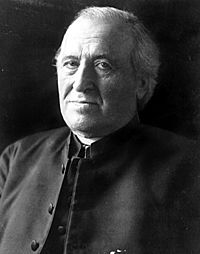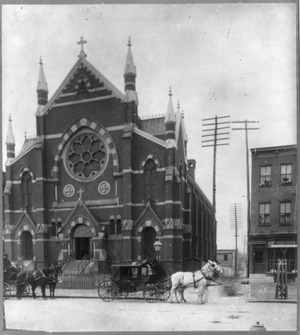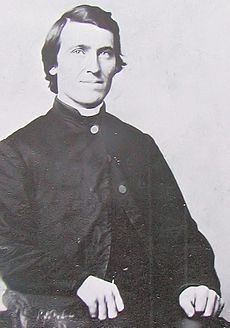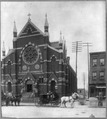John Ireland (bishop) facts for kids
Quick facts for kids The Most Reverend John Ireland |
|
|---|---|
| Archbishop of Saint Paul | |
 |
|
| Archdiocese | Saint Paul |
| Diocese | Saint Paul |
| Appointed | July 28, 1875 |
| Enthroned | July 31, 1884 |
| Reign ended | September 25, 1918 |
| Predecessor | Thomas Grace |
| Successor | Austin Dowling |
| Orders | |
| Ordination | December 21, 1861 |
| Consecration | December 21, 1875 by Thomas Grace, Michael Heiss, and Rupert Seidenbusch |
| Personal details | |
| Born | unknown, baptized September 11, 1838 Ireland |
| Died | September 25, 1918 (aged 80) Saint Paul, Minnesota |
John Ireland (born September 11, 1838 – September 25, 1918) was an important American religious leader. He became the third Roman Catholic bishop and the first archbishop of Saint Paul, Minnesota. He served in this role from 1888 until 1918.
Archbishop Ireland was a strong leader in both religious and community matters in Saint Paul around the start of the 1900s. He was known for his modern ideas about education, helping immigrants, and the relationship between church and government. He also spoke out against saloons and political corruption. Ireland believed in making Catholicism more "American," especially by supporting new social ideas. He was a key figure in the Catholic Church's efforts to modernize during the Progressive Era. He helped create many religious and educational places in Minnesota.
Contents
John Ireland's Early Life and Career
John Ireland was born in Burnchurch, County Kilkenny, Ireland. He was baptized on September 11, 1838. His family moved to the United States in 1848. They later settled in Saint Paul, Minnesota, in 1852.
A year later, Joseph Crétin, the first bishop of Saint Paul, sent Ireland to study in France. Ireland became a priest in Saint Paul in 1861. He served as a chaplain (a religious leader) for the 5th Minnesota Volunteer Infantry Regiment during the American Civil War. He left in 1863 due to poor health. After the war, he became well-known across the country.
In 1867, he became the pastor at Saint Paul's cathedral. He held this job until 1875. In 1875, he was made a special assistant bishop for Saint Paul. In 1884, he became the main bishop. In 1888, his area became an "archdiocese," and he became an archbishop. He kept this title for 30 years until he passed away in 1918. Before he died, he burned all his personal papers.
Ireland was friends with Presidents William McKinley and Theodore Roosevelt. Even though most Irish Catholics at the time supported the Democratic party, Ireland was close to the Republican party. He spoke out against racial inequality. He called for "equal rights and equal privileges" for everyone.
Archbishop Ireland's Impact
Archbishop Ireland was a very influential person. He played a big part in movements for avoiding alcohol, helping people settle in the Northwest, and modern education. He became a leading figure in Saint Paul during the late 1800s and early 1900s. He worked well with people of all faiths. Many saw him as a leader among Catholics who wanted to modernize the church.
Ireland spoke up for racial equality when it was a very new idea in the U.S. On May 5, 1890, he gave a speech at St. Augustine's Church, Washington, D.C.. This church was important for the African-American community. Many important people, including government officials and members of Congress, listened to his speech. Ireland's speech on fairness for all people ended with a powerful statement: "The color line must go; the line will be drawn at personal merit." His brave words made a big impact across America.
Helping Immigrants Settle
Ireland heard that Catholic immigrants in big eastern cities were struggling. So, he and Bishop John Lancaster Spalding started the Irish Catholic Colonization Association. This group bought land in rural areas to the west and south. They helped Irish Catholics move from crowded city slums to these new places.
Ireland helped create many Irish Catholic settlements in Minnesota. He worked with railroads and the Minnesota state government. He helped over 4,000 Catholic families move from eastern cities. They settled on more than 400,000 acres (1,600 km2) of farmland in Minnesota.
In 1880, Ireland helped hundreds of people from Connemara, Ireland, move to Minnesota. They arrived at a difficult time of year. Local Freemasons, a group the Catholic Church often disagreed with, had to help them through a harsh winter. Several towns in Minnesota, like De Graff, Clontarf, Adrian, and Graceville, were colonies started by Ireland.
Ireland also supported setting up an information center and a temporary shelter for immigrants arriving in New York. This was at Castle Garden, where many immigrants first landed.
Improving Education
Ireland believed that Catholic schools should get support from the state and be inspected by them. When some Catholic schools were in danger of closing, Ireland sold them to the local public school boards. The schools continued to operate with nuns and priests teaching, but they could not teach religion during school hours. This plan caused some debate, and Ireland had to go to Vatican City to explain and defend it. He was successful.
He also supported the idea of everyone in America speaking English. He wanted this rule to be followed in American Catholic churches and schools. Many immigrants from Europe still spoke their native languages at the time. Ireland strongly encouraged German-Americans and other new immigrants to learn and use English right away. He wrote a book called The Church and Modern Society in 1897.
There were disagreements between Archbishop Ireland and Bishop John Joseph Frederick Otto Zardetti of St. Cloud. Zardetti felt that Ireland's modern ideas about theology were too extreme. Zardetti also believed that being an American patriot could go along with teaching and keeping the German language in the United States and other native languages.
Relations with Eastern Catholics
In 1891, Ireland refused to accept a priest named Alexis Toth. Toth was a Ruthenian Catholic priest who followed the Byzantine Rite. Even though Toth was a widower (which was allowed in his rite) and had permission from his own bishop, Ireland would not let him serve his people. Ireland also tried to remove all non-Latin Church Catholic priests from the United States.
Because of this, Toth led thousands of Ruthenian Catholics away from the Roman Catholic Church. They joined what became the Orthodox Church in America. Some people jokingly call Archbishop Ireland "The Father of the Orthodox Church in America" because of this.
Places Founded by John Ireland

At a big meeting of Catholic leaders in Baltimore, they decided to create a Catholic university. In 1885, Ireland was chosen for a committee to help build The Catholic University of America in Washington, D.C.. He remained very interested in the university for the rest of his life.
He also founded Saint Thomas Aquinas Seminary. This seminary grew into four different schools: the University of Saint Thomas (Minnesota), the Saint Paul Seminary School of Divinity, Nazareth Hall Preparatory Seminary, and Saint Thomas Academy. The Saint Paul Seminary was built with help from James J. Hill, a Methodist whose wife was Catholic. Both schools are located on hills overlooking the Mississippi River.
DeLaSalle High School in Minneapolis opened in 1900. Archbishop Ireland gave $25,000 for it. Fourteen years later, he bought more land for the school as it grew.
In 1904, Ireland got the land for the current Cathedral of Saint Paul. It sits on Summit Hill, the highest point in downtown Saint Paul. Around the same time, in 1903, he also asked for the construction of the large Church of Saint Mary in Minneapolis. This church later became the Basilica of Saint Mary, the first basilica in the United States, in 1926. Both buildings were designed by the French architect Emmanuel Louis Masqueray.
John Ireland Boulevard, a street in Saint Paul that goes from the Cathedral to the Minnesota State Capitol, is named after him. It was named in his honor in 1961.
Images for kids











